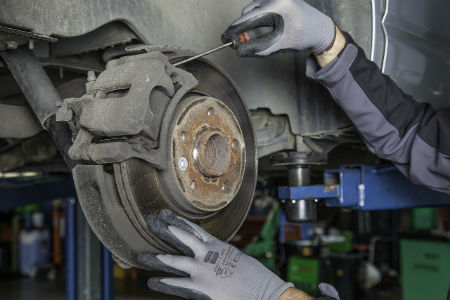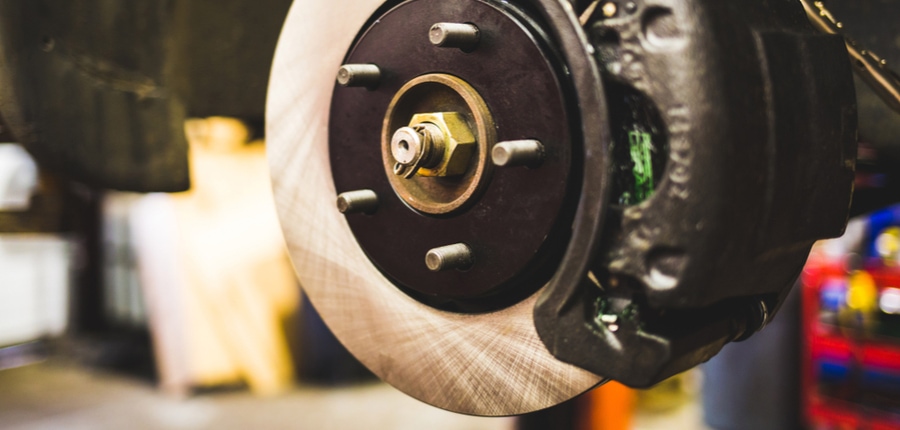This is one of the basic maintenance jobs on any vehicle. Every time you apply the brakes, the pads and rotors both wear a little bit. Once the pads and rotors are worn too thin, they need to be replaced.
Usually, the pads wear a little faster than the rotors. Because of this, sometimes, the rotors don’t need to be replaced. However, modern cars are usually built with thinner rotors than in the past and it’s more common nowadays that they are designed to wear out about the same time as the pads.
The Cost of a Brake Pad & Rotor Replacement
Most shops tend to sell brake jobs and brake and rotor replacement at a package price. Most manufacturer’s book time for a brake job is 2 hours per axle on almost all vehicles and that’s usually used as a basis.
Parts prices vary quite a bit. For both pads and rotors, there are wide varieties of economy lines, mid-priced parts, and high-end parts available. This allows a shop to quote a general average price for a packaged service and then, source whatever parts allow that price to work.
An idea of an estimated cost can be arrived at by checking with the larger auto service chains. Examples are Pep Boys, Goodyear, Firestone, and Point S.
All offer brake services at a basic package price – giving a range of $350 to $450 per axle for rotor replacement and brake job cost for most vehicles. Independent shops will usually be within that range as well. However, they are also more likely to offer a wide range of cost options that will suit the customer and the vehicle.
Some high-performance vehicles (such as Corvettes or performance-oriented European vehicles) are often inherently more expensive, harder to source parts for, and may involve special procedures; leading to different pricing structures. Light trucks and vehicles designed for towing with much larger brake systems are also sometimes on a different (higher) price schedule.
When to Know It’s Time to Replace?
Most of the time, brakes are inspected regularly when a vehicle has its oil changed and when a vehicle’s tires are rotated. Both of these are also normal maintenance – done perhaps every 5000 miles and checking the brakes during these services makes it fairly easy to keep track of the brake condition.
Usually, when the brakes are checked, it is the thickness of their pads that are measured, while rotors are only measured when necessary. Manufacturers provide the specs for the minimum pad thickness and also commonly use wear indicators that squeal when the pad is worn to specific thinness.
There is some variety in practice, but a normal “good” pad thickness is over 4 millimeters. Between 2 and 4 millimeters, usually, brake service is recommended. Below 2 millimeters, however, the brake service will be needed.
It’s worth mentioning that many states have specific regulations on how automotive repairs are represented and one of the common features is a legal definition for the word “needs” and the word “recommend”. An example would be the BAR guidelines in California.
It is generally a good practice in shops anywhere to be careful with language and to abide by the vehicle manufacturer’s specification as to when a repair is “needed” versus when a repair is “recommended”. And it is a good idea for consumers to be aware of the distinction as well and this comes up more often in brake work than in other areas.
Rotor replacement, for example, can be recommended at any time due to rust, warping or runout, surface imperfections or grooving, etc. But it only needs to be replaced when it becomes thinner than the manufacturer’s minimum specification or it can’t be machined without being made thinner than the minimum allowable.
Brake and Rotor Replacement at Dealerships

Dealerships will more often use a two-hour labor time for a brake job and actual parts list price on top of that. Examples of some estimates of the cost to replace brake pads and rotors on common vehicles using $100 an hour as a labor rate are as follows:
- For a 2007 Volkswagen Jetta, factory pads are about $90 for the front and $61 for the rear. Factory rotors are about $86 each for the front and about $45 each for the rear. This would make brake pad and rotor replacement about $462 for the front and about $351 for the rear at a dealership.
- For a 2009 Dodge Grand Caravan, factory pads are about $141 for both the front and the rear. Front rotors cost about $108 each and rear rotors cost about $40 each. This would make brake pad and rotor replacement about $557 for the front and about $421 for the rear at a dealership.
- For a 2010 Toyota Camry, factory pads are about $103 for the front and about $55 for the rear. Front rotors cost about $108 each and rear rotors cost about $84 each. This would make brake pad and rotor replacement about $519 for the front and about $423 for the rear at a dealership.
- For a 2008 Chevrolet Tahoe with four-wheel drive, factory pads are about $146 for the front and about $184 for the rear. Front rotors cost about $142 each and rear rotors cost about $134 each. This would make brake pad and rotor replacement about $630 for the front and about $652 for the rear at a dealership.
Of course, there is a wide variety of actual labor rates depending on the region and the market. And dealerships can have various price points even on OE parts through dealer sources and many will also offer aftermarket parts at competing prices for basic services such as brake work.
Labor Only Brake Services
One way to save money on a brake job is to purchase the parts online or from a parts store and then, have a shop install them. The general ease of the job and its nature as usually problem-free maintenance makes that an option worth looking at.
Not all shops will install parts that a customer provides. However, if the service is available, here are some brake repair cost estimates using the same vehicles listed above and the same $100 per hour labor rate:
- For a 2007 Volkswagen Jetta, a Power Stop pad and rotor kit costs about $95 for the front, and about $80 for the rear. Assuming a $200 labor per axle, the job could come out like $295 for the front and $280 for the rear.
- For a 2009 Dodge Grand Caravan, a Durago pad and rotor kit costs about $71 for the front and about $56 for the rear. This would make the job about $271 for the front and $256 for the rear.
- For a 2010 Toyota Camry, a Centric pad and rotor kit costs about $108 for the front and about $82 for the rear. This would make the job about $308 for the front and about $282 for the rear.
- For a 2008 Chevrolet Tahoe, a Raybestos pad and rotor kit costs about $104 for the front, and about $101 for the rear. This would make the job about $304 for the front, and about $282 for the rear.
The one big disadvantage of bringing your own parts is that you will typically get no warranty on the job; usually just for workmanship. And as brake work is one of the first basic things a mechanic learns and is relatively simple, if there’s a problem (such as squeaking), it’s usually not the workmanship.
But most of the time, brake parts work reliably as they should. Avoiding the high and low ends of the parts market is one way of staying safe. The low end has all the risks one might expect; fit issues, noise, early wear, etc. The high end is often more oriented to racing or very heavy use and will often not perform as well under normal or light use.
Ceramic Versus Semi-Metallic
This is sometimes presented as a choice when brake work is needed. There are two different types of brake pad materials with different characteristics. But without getting into the pros and cons of the argument for either, the more important thing is that every vehicle will be engineered for one or the other.
The best choice is almost always going to be to use the type of brake pads that a vehicle was designed for. The two pad materials use different friction strategies (adhesive friction for ceramic pads, abrasive friction for semi-metallic pads), and this affects the design of the rotor, the amount of boost in the brake system, the size of the caliper piston, the calibration of the ABS system, etc.
It’s best to use an OE-matched brake pad; whichever one the vehicle’s brake system was designed around.

Other Things That May Be Recommended
Most of the time, a brake service will require nothing more than brake pads and rotors. But one of the things that might be recommended is brake caliper replacement.
When the brake pedal is applied, the fluid is pushed into the brake caliper on each wheel. This moves the caliper piston forward and forces the brake pads against the rotor. The caliper uses slide pins so that it can move freely and apply force to both sides of the rotor evenly.
Part of a normal brake service is lubricating the slide pins which have rubber seals to keep weather and grit out and hold the lubricating grease in. Sometimes the seals fail, sometimes the grease dries out, and sometimes corrosion prevents free movement which can’t always be restored without replacing parts.
There is also a seal inside the caliper that bears against the caliper piston and holds the brake fluid pressure. If this leaks or if the piston can’t move freely in its bore, the caliper is normally replaced.
It is possible to replace slides and it is possible to rebuild calipers with new internal parts. However, the usual practice is to replace the calipers in pairs if one or both have failures.
Brake fluid is carried to each caliper by a brake hose which is made of flexible rubber to allow it to move with the steering and with the up and down of the suspension. Sometimes, age and wear can cause cracks in the outer rubber which allows moisture into the hose casing which can lead to rapid failure.
A brake hose with visible cracks needs to be replaced. For the same reason that brake calipers are replaced in pairs (in order that braking forces will be as even as possible on both sides of a vehicle), it is usually recommended to replace brake hoses in pairs.
The other common recommendation during a brake service is a brake fluid flush. If the brake fluid is due for maintenance, the easiest time is during a brake service.
Another factor then is that when brakes are worn, the piston is extended and a relatively large amount of fluid resides in the caliper. In order to install new brake pads, the piston must be pushed back into its bore which forces the old fluid back into the brake lines and the brake master cylinder.
The brake system is designed for this and it generally causes no problems. But if the fluid is due for replacement, then, it is a better practice to drain it from the caliper rather than force it back into the system.
Cost Saving Tips
While most maintenance occurs on a regular time or mileage schedule, brake service is done typically only when the brake pads have worn down below 4 mm. How long this takes varies greatly from vehicle to vehicle and depending on how it is driven.
A vehicle that spends much of its time in highway travel might easily get more than 100,000 miles out of a set of brakes. One the other hand, the same vehicle might only get 20,000 miles if it mostly saw stop and go traffic.
This goes to show that it is a good practice to stay aware of the condition of the brake system and ask how the brakes are when the vehicle is in for regular services.
The most expensive time to require brake work is typically when it is completely unsuspected such as during a trip or when there is no time for the work to be scheduled. But brakes usually wear very gradually and predictably and it’s not hard to figure out when they are likely to need to be replaced.
Another good practice is – if they are recommended to be replaced, look at them. Most shops are honest and are willing to show a customer the problems or wear that they are giving an estimate on.
There are also many vehicles where the brake pads can be easily seen even with the wheels on through the openings in the rims. Another practice that some people advocate, as far as “keeping honest mechanics honest”, is to ask for the old parts back.
Of course, no one really wants old parts back, but this gives the opportunity for the necessity of the work to be verified at any point after the repairs are done.
A shop that asks what kind of driving you do when you drop off a vehicle for brake work is a good sign. There are almost always numerous brake pads options available.
The best choice likely won’t be the cheapest or the dearest, but the one that best matches both the vehicle and the driver. A lightly used vehicle with a slow driver, for instance, is sometimes best with a soft, relatively cheap brake pad.
An SUV that frequently carries passengers and is mostly used in stop and go driving will be best with a harder, severe-duty brake pad. A pad that is too hard for the way it is used will tend to glaze and squeak, while a pad that is too soft for the way it is used will wear rapidly.
The cheapest way to do the job is to do it once with the correct pads such that it remains trouble-free until the next normal service maintenance.

